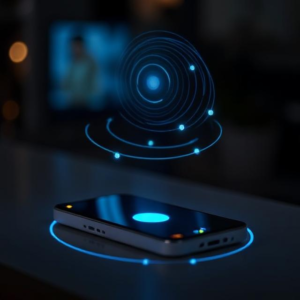Motion sensing technologies are used in smart devices to detect movement or changes in position. These technologies allow devices to respond to how they are moved or tilted, making them more interactive and intuitive to use.

1. What is Motion Sensing?
Motion sensing means detecting changes in the position, speed, or orientation of an object. In the case of smart devices, it allows the device to know when it is being moved or rotated, and it can use this information to perform certain actions.
2. How Motion Sensing Works
There are several technologies used in motion sensing, but the most common ones in smart devices are:
- Accelerometers: These sensors measure acceleration, or the rate of change in velocity. They can detect movement in three directions (X, Y, and Z axes). When you tilt or move your phone, the accelerometer detects this change and can tell the phone whether it’s in portrait or landscape mode, or whether you’re shaking the device.
- Gyroscopes: These sensors measure rotational movement. A gyroscope detects changes in the orientation of a device, such as whether it’s rotating left, right, or upside down. When you rotate your phone or tablet, the gyroscope helps determine its position.
- Magnetometers: These sensors work like a digital compass. They measure the strength and direction of magnetic fields. This can help determine the orientation of a device in relation to the Earth’s magnetic field, useful for navigation apps or augmented reality (AR).
- Infrared Sensors (IR): Some devices use infrared sensors to detect motion by sending out infrared light and measuring the reflection. These sensors are often used in motion-activated lights or smart home devices like thermostats.
- Ultrasonic Sensors: These sensors send out sound waves (usually above the human hearing range) and measure how long it takes for the sound waves to bounce back. This helps detect motion or measure the distance of objects.
3. Applications of Motion Sensing in Smart Devices
Motion sensing is used in a wide range of smart devices, including smartphones, tablets, wearables (like smartwatches), and smart home devices. Here are some common uses:
- Screen Orientation: When you turn your phone from vertical to horizontal, the accelerometer detects the change and automatically adjusts the screen to match the new orientation.
- Fitness Tracking: Wearable devices like fitness trackers or smartwatches use accelerometers and gyroscopes to track your steps, movement, and even monitor your posture.
- Gesture Control: Some devices use motion sensing to recognize specific gestures. For example, waving your hand in front of your phone or smart TV might allow you to change the volume or scroll through content.
- Gaming: Motion sensing is popular in gaming consoles, like the Nintendo Wii or PlayStation Move, where you physically move the controller to interact with the game. It can also be used in augmented reality (AR) games.
- Smart Home Automation: In smart home devices, motion sensors can turn lights on or off when they detect movement, adjust the temperature, or activate security cameras when someone is present.
4. Example in Real Life
Imagine you’re using your smartphone to take a picture. If you tilt the phone to the side (landscape mode), the accelerometer detects that the phone has been rotated and switches the screen layout to fit the new orientation. Or if you’re playing a game, the gyroscope detects the tilting of your phone and makes the character on the screen move in response to how you tilt the device.
Summary
Motion sensing technologies in smart devices use sensors like accelerometers, gyroscopes, and infrared to detect movement and position changes. These sensors enable devices to automatically adjust, track your activity, or respond to gestures, making them smarter and easier to interact with.
Tags: accelerometer sensor, accelerometer vs gyroscope, AR motion sensing, augmented reality sensors, automatic screen orientation, device movement tracking, device orientation detection, digital compass sensor, fitness tracker sensors, gaming motion sensors, gesture recognition sensor, gyroscope sensor, infrared motion sensor, interactive motion sensing, magnetic field sensor in smartphones, magnetometer sensor, mobile gaming sensors, motion control in smart homes, motion detection technology, Motion Sensing, motion sensing in smart devices, motion sensing in smartphones, motion sensing in smartwatches, motion sensing in tablets, motion sensor for lights, motion sensors, motion tracking technology, Nintendo Wii motion control, PlayStation Move motion sensing, real-time motion detection, responsive device sensors, screen rotation sensor, sensor-based gesture control, sensor-based user interaction, smart device motion control, smart home motion sensors, smart motion detection, smart sensor applications, ultrasonic motion sensor, wearable motion sensors, what is motion sensing


